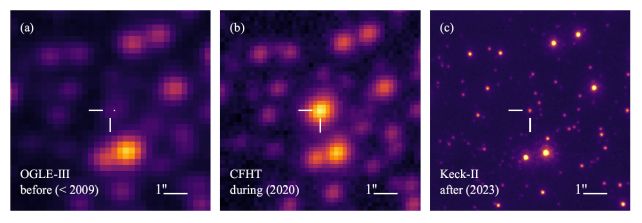
"The white dwarf lens was nearly perfectly aligned with the background source star during the event, causing it to be magnified by over 1,000 times," Zhang explained.
"For these rare ultra high magnification microlensing events, a companion as small as a terrestrial planet could significantly affect the magnification pattern, enabling us to accurately infer the lens configuration across a wide range of masses and orbital separations."
This allowed the researchers to not just determine the mass and orbital separation of the Earth-like, or terrestrial, exoplanet, but the presence of a brown dwarf orbiting the white dwarf, too, an object about 30 times the mass of Jupiter.
It's a sort of weird in-between that's too big for a planet, but too small for a star – just massive enough to fuse deuterium in its core, but not massive enough for the hydrogen fusion that defines a star.
The white dwarf is around half the mass of the Sun, suggesting that it was originally pretty close to the mass of the Sun before it kablooeyed its guts out. And the current orbital separation between the terrestrial exoplanet and the white dwarf suggests it was once at around the same distance Earth is from the Sun, 1 astronomical unit, before being pushed farther out as the star died.
"The planet's current orbit of 2.1 astronomical units is around exactly where you would expect to find planet Earth after the Sun has become a white dwarf
"Models currently disagree whether or not Earth can avoid being engulfed because we do not know the mass loss rate of the red giant sun precisely enough. Thus our discovery suggests some of the models predicting against Earth's survival may be too pessimistic. At the end of the day Earth may just narrowly escape being engulfed similar to our discovered system."
Life on Earth will either be long gone, or dramatically different, by the time the Sun's red giant phase rolls around. The Sun is growing hotter and brighter over time – not enough that we'd notice it in the here and now, but in about a billion years, it will be so hot that all the water on Earth will evaporate. The world that's left will be deeply inhospitable to life as we know it.
But maybe by that time, we'll have found a way to make a life elsewhere.
"As the Sun becomes a red giant, the habitable zone will move to around Jupiter and Saturn's orbit, and many of these moons will become ocean planets," Zhang said. "I think, in that case, humanity could migrate out there."
The team's research has been published in Nature Astronomy.















No comments